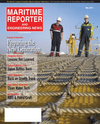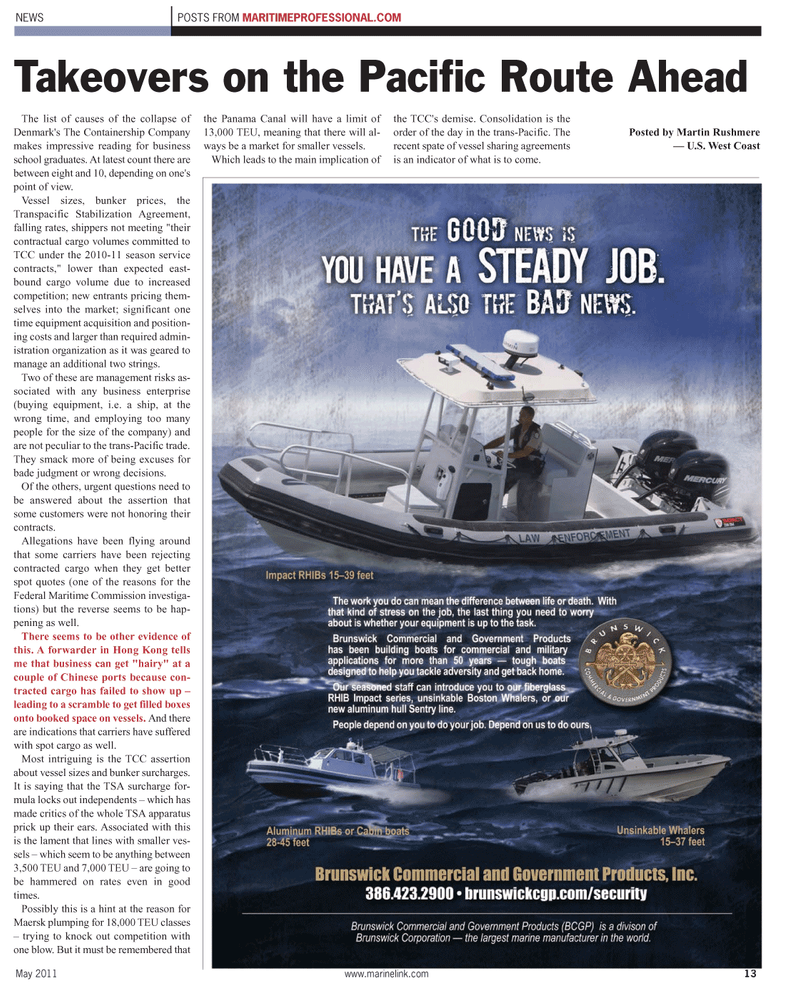
Page 13: of Maritime Reporter Magazine (May 2011)
Training & Education Edition
Read this page in Pdf, Flash or Html5 edition of May 2011 Maritime Reporter Magazine
May 2011 www.marinelink.com 13
NEWS POSTS FROM MARITIMEPROFESSIONAL.COM
The list of causes of the collapse of
Denmark's The Containership Company makes impressive reading for business school graduates. At latest count there are between eight and 10, depending on one's point of view.
Vessel sizes, bunker prices, the
Transpacific Stabilization Agreement, falling rates, shippers not meeting "their contractual cargo volumes committed to
TCC under the 2010-11 season service contracts," lower than expected east- bound cargo volume due to increased competition; new entrants pricing them- selves into the market; significant one time equipment acquisition and position- ing costs and larger than required admin- istration organization as it was geared to manage an additional two strings.
Two of these are management risks as- sociated with any business enterprise (buying equipment, i.e. a ship, at the wrong time, and employing too many people for the size of the company) and are not peculiar to the trans-Pacific trade.
They smack more of being excuses for bade judgment or wrong decisions.
Of the others, urgent questions need to be answered about the assertion that some customers were not honoring their contracts.
Allegations have been flying around that some carriers have been rejecting contracted cargo when they get better spot quotes (one of the reasons for the
Federal Maritime Commission investiga- tions) but the reverse seems to be hap- pening as well.
There seems to be other evidence of this. A forwarder in Hong Kong tells me that business can get "hairy" at a couple of Chinese ports because con- tracted cargo has failed to show up – leading to a scramble to get filled boxes onto booked space on vessels. And there are indications that carriers have suffered with spot cargo as well.
Most intriguing is the TCC assertion about vessel sizes and bunker surcharges.
It is saying that the TSA surcharge for- mula locks out independents – which has made critics of the whole TSA apparatus prick up their ears. Associated with this is the lament that lines with smaller ves- sels – which seem to be anything between 3,500 TEU and 7,000 TEU – are going to be hammered on rates even in good times.
Possibly this is a hint at the reason for
Maersk plumping for 18,000 TEU classes – trying to knock out competition with one blow. But it must be remembered that the Panama Canal will have a limit of 13,000 TEU, meaning that there will al- ways be a market for smaller vessels.
Which leads to the main implication of the TCC's demise. Consolidation is the order of the day in the trans-Pacific. The recent spate of vessel sharing agreements is an indicator of what is to come.
Posted by Martin Rushmere — U.S. West Coast
Takeovers on the Pacific Route Ahead

 12
12

 14
14
